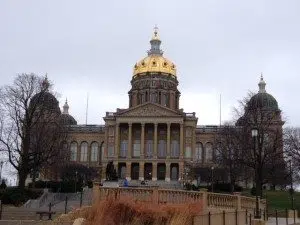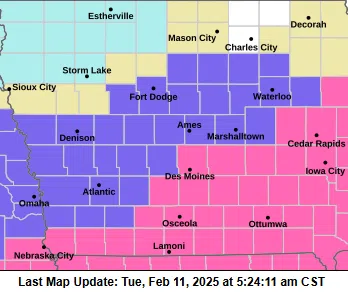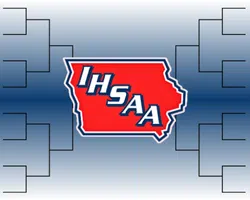(Des Moines) The Iowa House passed a bill Thursday with a 2.25% per-pupil funding increase alongside other funding changes for Iowa’s public K-12 schools. The move sends the legislation back to the Senate, which proposed a 2% rate.
The House voted 58-35 to pass an amended version of Senate File 167, reflecting the House Republicans’ State Supplemental Aid proposal introduced earlier in February. It includes a 2.25% SSA rate and other funding components like increasing transportation equity payments and adding a one-time boost of $22.6 million for per-pupil costs.
The Iowa Senate passed the legislation Tuesday with a 2% SSA rate that did not include the other funding components in a 29-18 vote.
Rep. Dan Gehlbach, R-Urbandale, the bill’s floor manager, said the measure was a “responsible and a sustainable increase” for Iowa’s public school funding.
“We believe in funding students and not systems, and this is a year-over-year increase that we continue to see,” in addition to addressing rural school districts’ needs through measures like transportation equity and incentivizing operational sharing of administrative staff between school districts, Gehlbach said.
Democrats and school advocates argued the House’s funding proposal, though better than the Senate’s, will not provide adequate funding for Iowa’s public K-12 system.
House lawmakers held a public hearing before voting on the measure Thursday. While more than 900 public comments were submitted online with a vast majority opposing the legislation and calling for higher funding for Iowa’s public K-12 system, only two speakers came to address members of the House Education Committee in person at the Capitol.
Anne Crosse, president of the the Des Moines Education Association and Ruth Henderson, a retired teacher representing the Iowa State Education Association, both asked lawmakers at the public hearing to provide a 5% SSA increase to give schools the ability to keep up with rising costs.
Crosse said many schools have outdated materials and overcrowded classes, and that a higher rate was needed to ensure students have access to quality education throughout the state. She also criticized the state’s funding of the Education Savings Account program, providing public funds for private school tuition and associated costs, while not providing higher funding for public education.
“The rising cost of running our schools has not been adequately addressed,” Crosse said. “Further, the private school voucher program in Iowa is exasperating the problem. With the state focusing on spending millions of dollars for just 40,000 students in private schools, the 480,000 students in our public schools are being shortchanged.”
Henderson and others with the ISEA have called for a “minimum” 5% SSA rate, saying higher funding of the state’s public K-12 system is needed to help school districts across the state that are facing budget cuts, leading to reductions in staff and fewer resources for students from individualized attention in classrooms to extracurricular activities.
“Setting SSA lower than 5% shortchanges our students, education professionals, and communities across the state that depend on their public schools,” ISEA President Joshua Brown said in a statement. “We implore the Iowa House to do everything they can so our public schools are best positioned to ensure our more than 480,000 students thrive.”
House Democrats proposed an amendment raising the SSA rate to 5%, alongside the other funding changes proposed by House Republicans. Rep. Heather Matson, D-Ankeny, said this change was needed because Iowa public schools are in “survival mode” due to years of lawmakers underfunding the state’s public education system.
“Let’s make a commitment today to support our public schools in the way we know they need, the way they have to told us they need, not just to survive, but get on a path to thriving,” Matson said.
Some speakers said the 2024 law making changes to the state’s Area Education Agencies has raised costs for schools, alongside other unfunded mandates proposed or enacted by state lawmakers, are adding costs to Iowa school districts while not providing resources needed for schools to implement these policies.
Rep. Monica Kurth, D-Davenport said for legislation being discussed this session requiring computer science classes for students in grades 9 through 12, and the governor’s proposal on math and civics education, a 5% SSA increase is needed to make these changes “actually achievable.”
“If school districts are mandated to make major curriculum changes, or add expensive classes like computer science, or mandated to improve scores, they must receive additional funding to make these things happen,” Kurth said. “Funding that falls below the current prediction of inflation, which is expected to be well over 3% in the coming year, does not allow for the time and money to make these things happen.”
Democrats in the Senate also proposed increasing the SSA rate to 5%. The Democrats’ amendments failed in both chambers.
Minority party members spoke in opposition to House Republicans’ proposed 2.25% per-pupil funding rate, saying the measure will increase property taxes in many Iowa communities — an impact at odds with GOP lawmakers’ stated goal of cutting property taxes this session. Matson said the House GOP funding proposal would put 146 of Iowa’s public school districts on budget guarantee, meaning that needed costs will be financed through increased property taxes when supplemental state aid does not meet funding obligations.
“Six billion dollars, that is the size of Iowa’s budget surplus,” Matson said. “When I say we can do better with school funding, I mean quite literally, we have the capacity in our budget to do better. It’s not a platitude, our amendment will increase school funding by $401 per student, rather than $186. Our amendment would significantly decrease the number of school districts that will need to raise local property taxes just to make ends meet.”
House Speaker Pat Grassley told reporters after floor debate that while Iowa school districts are all impacted by the Legislature’s appropriations, he noted that organizations including the School Administrators of Iowa, Iowa Association of School Boards and Rural School Advocates of Iowa were registered in support of the House proposal — a “strong sign” that the measure reflects the needs of Iowa school districts.
“That’s why we brought this bill forward, because it fits the needs of the schools … all across different school districts in Iowa,” Grassley said.
The amended legislation returns to the Senate for consideration. Grassley said that he has had conversations with members of the Senate about the House proposal about the additional funding components included in the legislation.
“I think we were in a position where we wanted to take firm action so that we could show, as a House, we supported this plan,” he said. “… I’m hopeful, as this bill now goes back to the Senate, they will take a look at what some of those other things are (on top of) the SSA.”













